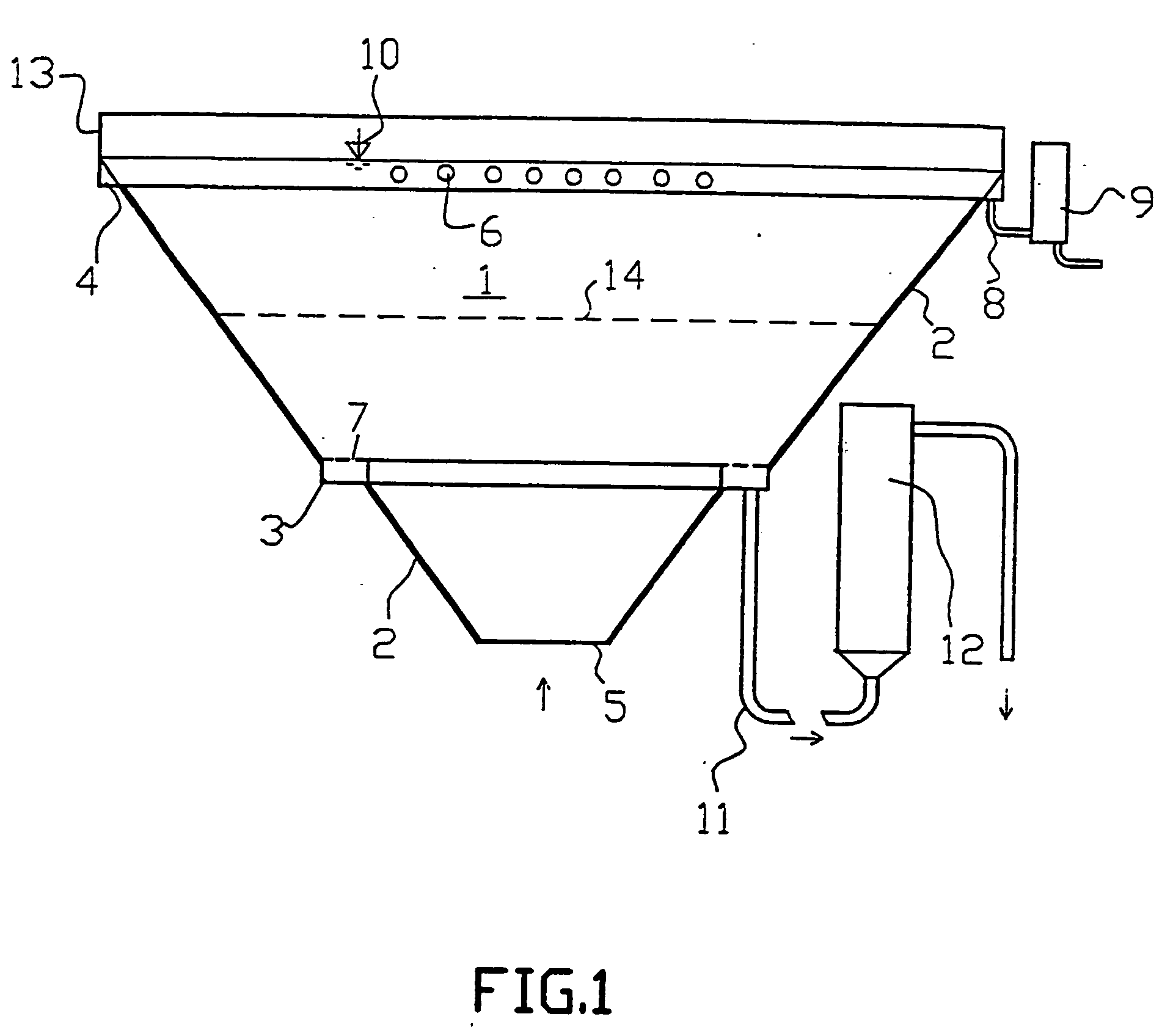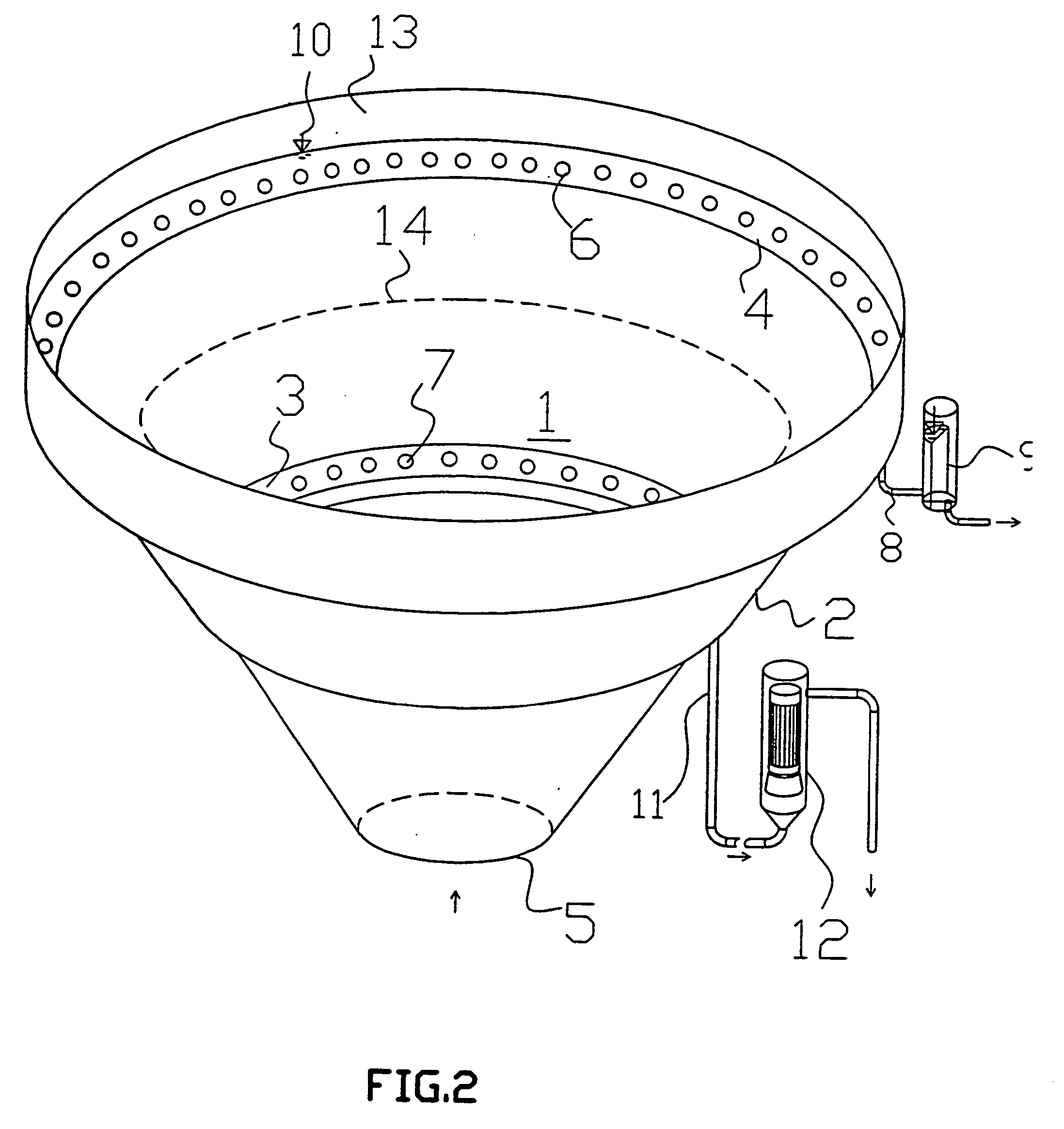Method of separating suspension, in particular for waste water treatment, and an apparatus for performing the same
- Summary
- Abstract
- Description
- Claims
- Application Information
AI Technical Summary
Benefits of technology
Problems solved by technology
Method used
Image
Examples
example 1
[0044] The basic part of the apparatus for the separation of flocculating suspension according to this invention is separator 1 in form of an upwards widening cone limited by outer wall 2 in shape of a conical casing (FIGS. 1, 2). The shape of the cone of separator 1 can be also non-continuous in the sense that it may comprise not illustrated short cylindrical parts, or even tapered parts of opposite inclination, e.g. due to manufacturing or design reasons.
[0045] The inner space of separator 1 contains a separation space; according to this example of embodiment the inner space of separator 1 practically co-incides with the separation space. The outer wall 2 comprises an inserted means for withdrawing the thickened suspension, and namely in form of a circular wound collecting tube 3 of angular section and its upper part accommodates another means for withdrawing liquid without suspension in form of circular wound collecting tube 4 of triangular section.
[0046] The height of withdraw...
example 2
[0067] The second example of embodiment of the apparatus according to the invention is illustrated in FIGS. 4 and 5. Separator 1 is, in analogy with example 1, essentially limited by the upward widening conical wall 2. The bottom part of separator 1 accommodates a conical inner wall 29 that is attached to the bottom edge of outer wall 2 with its bottom edge (FIG. 4). The inner wall 29 limits also the space that is broadening in the upward direction and reaches to the level of one third to one half of the height of separation space. The separation space, accordingly, is limited by inner wall 29 in the bottom part of separator 1 and by outer wall 2 in the upper part of the separation space. Thus the separation space is a part of the inner space of separator 1, which can be also expressed by saying that the inner space of separator 1 contains a separation space. The outer wall 2 above the upper edge 30 of the inner wall 29 has conical shape, whereas under the level of the upper edge 30...
example 3
[0072] The third example of apparatus according to the invention is illustrated in FIGS. 6 and 7.
[0073] This embodiment has a longitudinal separator 1 in form of an upward widening prism created by inclined outer walls 33 and 34 of which each accommodates at middle height, similarly as in example 1, collecting tubes 35 and 36 for withdrawal of thickened suspension that are connected with the re-circulation pump 12. The inner space of separator 1 represents the separation space. The collecting tubes 35 and 36 are part of the inclined outer walls 33 and 34 whose parts are attached to these tubes. In the place of collecting tubes 35 and 36 the upper parts of outer walls 33 and 34 are shifted against the bottom parts so that separator 1 and, consequently, also the separation space, get broadened by a jump in this place. The collecting tubes 35 and 36 for the withdrawal of thickened suspension are provided with holes 37 that are provided in the sides of tubes 35 and 36 that are turned t...
PUM
| Property | Measurement | Unit |
|---|---|---|
| Fraction | aaaaa | aaaaa |
| Fraction | aaaaa | aaaaa |
| Angle | aaaaa | aaaaa |
Abstract
Description
Claims
Application Information
 Login to View More
Login to View More - R&D
- Intellectual Property
- Life Sciences
- Materials
- Tech Scout
- Unparalleled Data Quality
- Higher Quality Content
- 60% Fewer Hallucinations
Browse by: Latest US Patents, China's latest patents, Technical Efficacy Thesaurus, Application Domain, Technology Topic, Popular Technical Reports.
© 2025 PatSnap. All rights reserved.Legal|Privacy policy|Modern Slavery Act Transparency Statement|Sitemap|About US| Contact US: help@patsnap.com



